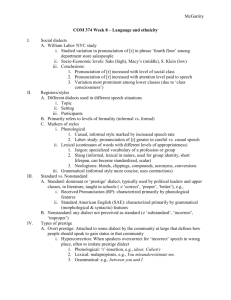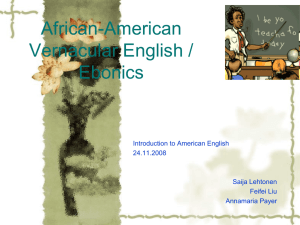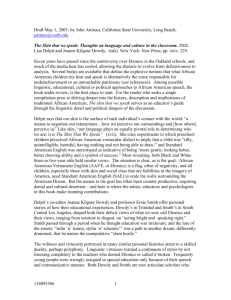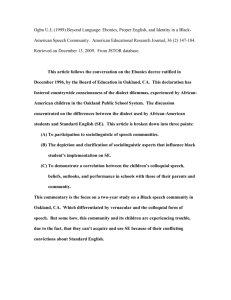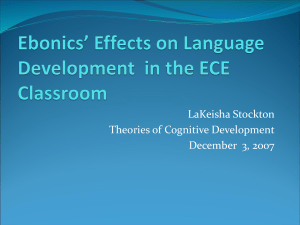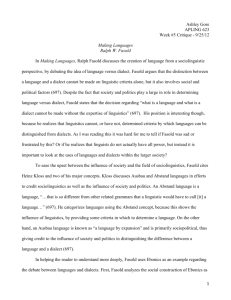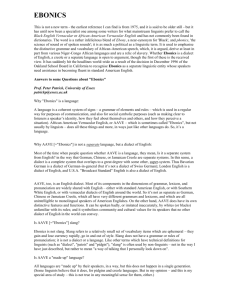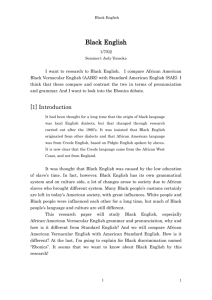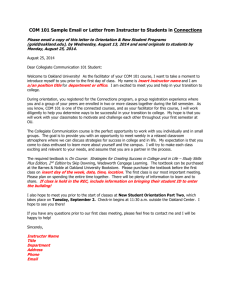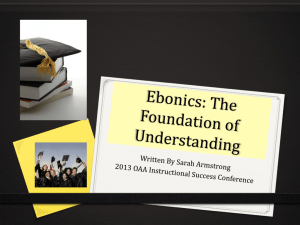Hooked on Ebonics
advertisement
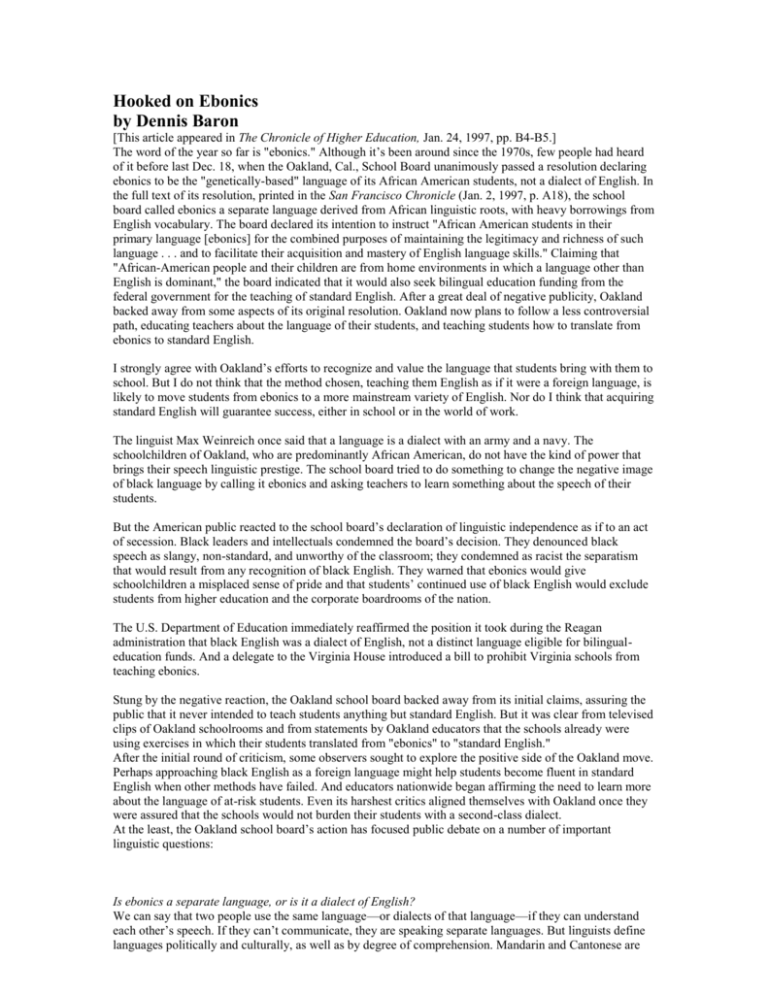
Hooked on Ebonics by Dennis Baron [This article appeared in The Chronicle of Higher Education, Jan. 24, 1997, pp. B4-B5.] The word of the year so far is "ebonics." Although it’s been around since the 1970s, few people had heard of it before last Dec. 18, when the Oakland, Cal., School Board unanimously passed a resolution declaring ebonics to be the "genetically-based" language of its African American students, not a dialect of English. In the full text of its resolution, printed in the San Francisco Chronicle (Jan. 2, 1997, p. A18), the school board called ebonics a separate language derived from African linguistic roots, with heavy borrowings from English vocabulary. The board declared its intention to instruct "African American students in their primary language [ebonics] for the combined purposes of maintaining the legitimacy and richness of such language . . . and to facilitate their acquisition and mastery of English language skills." Claiming that "African-American people and their children are from home environments in which a language other than English is dominant," the board indicated that it would also seek bilingual education funding from the federal government for the teaching of standard English. After a great deal of negative publicity, Oakland backed away from some aspects of its original resolution. Oakland now plans to follow a less controversial path, educating teachers about the language of their students, and teaching students how to translate from ebonics to standard English. I strongly agree with Oakland’s efforts to recognize and value the language that students bring with them to school. But I do not think that the method chosen, teaching them English as if it were a foreign language, is likely to move students from ebonics to a more mainstream variety of English. Nor do I think that acquiring standard English will guarantee success, either in school or in the world of work. The linguist Max Weinreich once said that a language is a dialect with an army and a navy. The schoolchildren of Oakland, who are predominantly African American, do not have the kind of power that brings their speech linguistic prestige. The school board tried to do something to change the negative image of black language by calling it ebonics and asking teachers to learn something about the speech of their students. But the American public reacted to the school board’s declaration of linguistic independence as if to an act of secession. Black leaders and intellectuals condemned the board’s decision. They denounced black speech as slangy, non-standard, and unworthy of the classroom; they condemned as racist the separatism that would result from any recognition of black English. They warned that ebonics would give schoolchildren a misplaced sense of pride and that students’ continued use of black English would exclude students from higher education and the corporate boardrooms of the nation. The U.S. Department of Education immediately reaffirmed the position it took during the Reagan administration that black English was a dialect of English, not a distinct language eligible for bilingualeducation funds. And a delegate to the Virginia House introduced a bill to prohibit Virginia schools from teaching ebonics. Stung by the negative reaction, the Oakland school board backed away from its initial claims, assuring the public that it never intended to teach students anything but standard English. But it was clear from televised clips of Oakland schoolrooms and from statements by Oakland educators that the schools already were using exercises in which their students translated from "ebonics" to "standard English." After the initial round of criticism, some observers sought to explore the positive side of the Oakland move. Perhaps approaching black English as a foreign language might help students become fluent in standard English when other methods have failed. And educators nationwide began affirming the need to learn more about the language of at-risk students. Even its harshest critics aligned themselves with Oakland once they were assured that the schools would not burden their students with a second-class dialect. At the least, the Oakland school board’s action has focused public debate on a number of important linguistic questions: Is ebonics a separate language, or is it a dialect of English? We can say that two people use the same language—or dialects of that language—if they can understand each other’s speech. If they can’t communicate, they are speaking separate languages. But linguists define languages politically and culturally, as well as by degree of comprehension. Mandarin and Cantonese are not mutually intelligible, yet both are Chinese. They are held together by an army and a navy and share a common writing system as well as a common cultural definition of what it means to be Chinese. Serbian and Croatian are mutually intelligible, though they use different alphabets, but because of their two separate armies what once was Serbo-Croatian is now considered by Serbs and Croats to be two separate languages. Most linguists, myself included, think of black English, or African American Vernacular English (AAVE) as a dialect of English. It may exhibit some features derived from African languages, but it is readily recognizable and understandable as English. Afrocentrists may see a political and cultural advantage in calling AAVE ebonics and treating it as an independent language, but even Oakland has backed away from this separatist position. In any case, the linguistic differences that do exist in the United States are symptoms of separateness, not its causes. Language barriers are erected at social borders as well as national frontiers. When social mobility for speakers of a language is low, dialects abound; when mobility is high, linguistic as well as other distinctions tend to disappear. It seems to me that if Oakland is prepared to characterize its students as strangers in a strange land, in need of learning English as a second language, it is doing so out of a fear that Americans really are drifting farther apart. Are ebonics and other dialects of English simply incorrect, sloppy speech? American schools, particularly in the northern United States, have treated AAVE as a form of language requiring remediation by speech pathologists or special-education teachers. But linguists have known for some time that non-standard dialects, such as AAVE and Hawaiian Creole, to name another example, are consistent, legitimate varieties of language, with rules, conventions, and exceptions, just like standard English. These dialects do not carry the prestige of standard English, but they influence and enrich the standard language, keeping it vibrant and constantly evolving. Examples from black English abound: in an article on ebonics, the New York Times cited Richard Nixon’s use of "right on!" "Rip-off," "chill out," and "dis" are other popular borrowings. Hawaiian gives us "aloha," and Hawaiian Creole expressions permeate travel brochures as well as the English of the islands. Furthermore, we know that all speakers of a language are able to adapt it to fit changing social circumstances. Given sufficient exposure to new situations, all language users can switch between prestige and non-prestige forms, between formal and informal ones, between intimate and polite ones, without explicit instruction or conscious translation. Americans, no matter what dialect they speak, are exposed to standard English through television. As a result, AAVE is not all that different from standard English. It seems then that it takes more than dialectal differences to account for the lack of success in school. Are foreign-language teaching techniques useful in teaching English-speaking students standard English? Although educators using translation techniques have claimed success in raising the scores of ebonics speakers on standardized tests, others find these claims unproved. Moreover, it seems alienating and misdirected to teach English as a second language to students who already speak English as their first language, if you believe as I do that ebonics is just a dialect of English. When the Oakland school board explained that it was simply having students translate from ebonics to standard English, rather than teaching students both ebonics and standard English, many critics began to relax, for that strategy looked like something they could live with. But second-language educators do not rely on translation alone. Instead they offer a rich combination of immersion and explicit teaching: students not only study vocabulary and grammar, they converse, role play, read newspapers and magazines, watch television and movies, and most important, interact with fluent users of the language in authentic communication situations. Similarly, students who speak nonstandard varieties of English will become fluent in the more mainstream forms of English only if they can first break down social barriers and participate as equals in authentic, mainstream social contexts. Even with such varied methods, foreign language instruction in our schools does not typically create fluent speakers. Everyone who has taught or taken a foreign language in school knows the difficulty of getting students to learn a language well in a classroom situation. Simply translating from one language to another is never enough to achieve fluency. It would be a mistake, too, to think that Oakland’s plan for translating from black to standard English will solve the reading and writing problems of the students in its schools. Do we really want to condemn students to speaking English as well as the typical American high-schooler speaks French or Spanish? Don’t students need standard English to be successful in school and in the workplace? Perhaps. But it is also true that discrimination—on account of their language—against people who speak non-standard English usually masks other, more sinister forms of prejudice. Women and members of every ethnic and racial minority have found that mastering the mainstream varieties of English—say, legal language, business English, or technical jargon—by itself will not guarantee them equal treatment. Even if your language is irreproachable, if teachers, employers, or landlords want to discriminate against you, they will find another way to do so. Standard English may be necessary, but it is seldom sufficient, for school and workplace success. And if our sports heroes, media celebrities, and public figures are anything to judge by, success is often achieved without standard English. In addition, few of the success stories of first-generation immigrants to this country involve the learning of impeccable standard English. Is ebonics only "a black thing"? No. For one thing, not all African Americans speak ebonics, and not all ebonics speakers are African American. A significant number of whites, Hispanics, and Asian Americans who live and work closely together speak dialects that can be characterized as black English. As linguists study AAVE, they find that, just like standard English, it is not monolithic, but comes in flavors and varieties. In addition, as I’ve indicated above, mainstream English has borrowed heavily from the speech of African Americans. So, in many ways, it is easier to conceive of all the dialects of English as variable and continuous, rather than categorical and separate. For another thing, the problems ebonics speakers face are shared by speakers of other nonstandard dialects as well, whether they live in the inner city, in rural America, or even in the suburbs. As this discussion suggests, the flap over ebonics is more complex than the school board’s action and the initial public response indicate. It raises crucial questions about the workings of language and our attitudes toward its use, especially in school contexts. Many teachers assume that their students are empty vessels waiting to be filled with knowledge. But by the age of five or six, students already have learned more about their native language than they will learn from school. Teachers must learn to recognize the rich and flexible linguistic talent that students already possess, working with it as they move students not toward a monolithic, mechanical correctness, but toward increasing linguistic depth and flexibility. The teacher’s job is not merely to conduct lessons in translation, but to introduce students to, and get them to function more comfortably in, new and ever more diverse language environments. It is this richness and flexibility, rather than strict adherence to a vaguely-defined standard, that will bring about successful communication. Non-English-speaking immigrants have found that learning English does not guarantee they will make their way in American society. In the same way, speakers of nonstandard forms of English, whether or not they are members of a racial or ethnic minority, may find that it takes a lot more than speaking standard English to get accepted into the mainstream. Sometimes it takes an army and a navy. Or the Supreme Court and the National Guard. Or the Civil Rights Act. Or perhaps a school board waking us up to a long-neglected problem. We must not reject Oakland’s attention to ebonics out of hand. Teachers are seldom adequately trained to deal with the language that students bring with them to the classroom, whether those students are suburban, rural, urban, or inner-city. The Oakland ebonics question has opened the way for much-needed linguistic training, for teachers as well as students. We must make sure such training is both available and effective. But increased efforts to work with students’ language will not solve the problems of inner-city schools. Translating into standard English will not replace lack of textbooks, deteriorating schools, overcrowded classrooms, and canceled affirmative action programs as a tool for solving the educational, social, and economic ills of the nation. _______________ Dennis Baron is professor of English and linguistics at the University of Illinois at Urbana-Champaign
